Roberta Pearson, in her entry on biblical films in the 'Encyclopaedia of Early Cinema' (2005) writes that the 1907 Pathé version, Vie et Passion de Notre Seigneur Jésus-Christ, "was probably seen by more people in North America and Europe (and more than once) than any other film of the period." She also stresses that these biblical films heavily relied upon "previous intertexts such as a long tradition of biblical illustration, including illustrated Bibles, stereoscope cards, magic lantern slide series, and illustrated lectures." The 1907 Pathé version confirms this too, even if not as explicit as the later From the Manger to the Cross (Kalem, 1912), which faithfully copied the Bible illustrations by James Tissot for his 1896-1897 French Bible. Ivo Blom collects the postcards of Vie et Passion de Notre Seigneur Jésus-Christ/Life and Passion of Christ (Ferdinand Zecca, 1907).
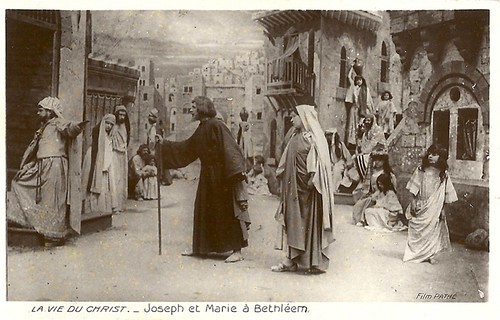
French postcard. Photo: Pathé Frères. Scene from the early Pathé film La vie du Christ aka Vie et passion de notre seigneur Jésus-Christ (Ferdinand Zecca, 1907). Caption: Joseph and Maria at Bethlehem.
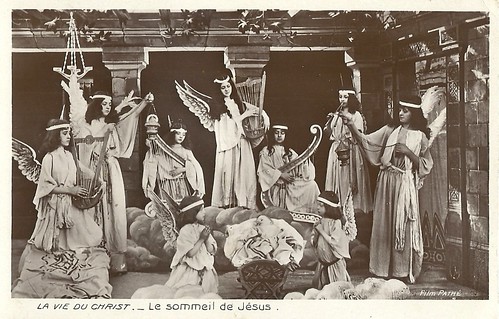
French postcard. Photo: Pathé Frères. Scene from the early Pathé film La vie du Christ aka Vie et passion de notre seigneur Jésus-Christ (Ferdinand Zecca, 1907). Caption: The Sleep of Jesus.
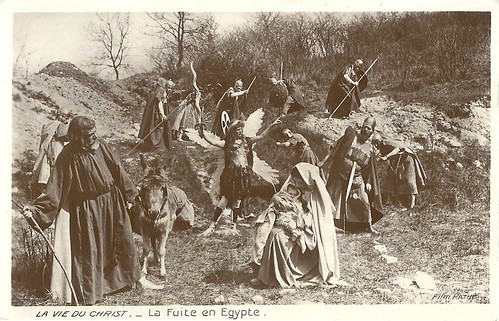
French postcard. Photo: Pathé Frères. Scene from the early Pathé film La vie du Christ aka Vie et passion de notre seigneur Jésus-Christ (Ferdinand Zecca, 1907). Caption: The Flight to Egypt.
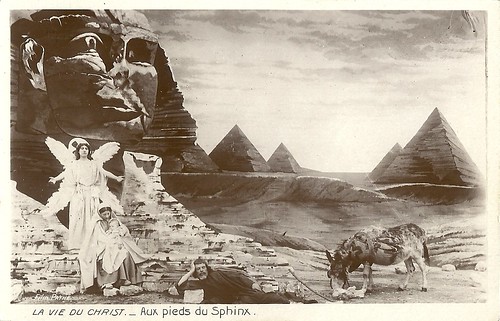
French postcard. Photo: Film Pathé. Scene from the early Pathé film La vie du Christ aka Vie et passion de notre seigneur Jésus-Christ (Ferdinand Zecca, 1907). Caption: At the Feet of the Sphinx.

French postcard. Photo: Pathé Frères. Scene from the early Pathé film La vie du Christ aka Vie et passion de notre seigneur Jésus-Christ (Ferdinand Zecca, 1907). Caption: The Wedding at Cana. The actress on the right is Julienne Mathieu, a regular at Pathé in its early years. She plays the Holy Virgin Mary.
Miraculous moments created by classical theatrical effects
Typical in the 1907 Pathé film is the tableau style in which every shot is preceded by an intertitle, which uses few words to indicate the scene and always in Pathé's patented red colour (likewise, Gaumont used green for its intertitles). While most shots use painted backdrops, still all kinds of sets, props, and people were used to create some deep staging, even if on a modest scale. Deepness could even be accentuated by diagonals of people simultaneously crossing the screen and approaching the camera, e.g. in the Adoration of the Magi. Also, at times, inserts (cut-ins) were used to stress details, such as the Veil of Veronica or the Ecce Homo moment of the scourged, bound Jesus, crowned with thorns. Miraculous moments were created by classical theatrical effects but also by modern cinematic effects such as stop motion (e.g. the appearance of the angels) and double exposure (e.g. Jesus walking on the water).
Moreover, when comparing the Pathé postcards with the film, some cards show a certain kind of compressed, simultaneous happening actions, which are spread out over time within the film. A good example is the scene of Joseph and Mary in Bethlehem. In the film, we first see a lively street with many extras. They disappear when the holy couple appears. In vain, Joseph and Mary ask for shelter from the innkeeper on the left, while later on the girl on the right directs them to an offscreen space on the right, clearly the stable. On the card, we see the innkeeper, the girl, the couple, and the extras altogether.
Scholars discussed who directed the film. It is clear that Ferdinand Zecca, who also co-directed with Lucien Nonguet the 1903 version, was the main director for the 1907 version as well. There are suggestions the Spanish special effects 'wizard' Segundo De Chomon, who was probably responsible for all the trick photography in the film, may have been co-director as well for the film. Others contest this. In any case, De Chomon's wife Julienne Mathieu clearly plays the Holy Virgin Mary, while it is unclear who played Jesus. The film was released in bright stencil colouring, announced as 'Pathé-Coloris'. It increases the pictorial qualities of the images.
When Kalem's From the Manger to the Cross was released in the Netherlands, Dutch film distributor Jean Desmet (re-)released the Pathé 1907 version with the title Van de Kribbe tot het Kruis, a Dutch translation of the Kalem title, angering Kalem and the local Dutch distributor. When under attack, Desmet coolly reposted that he at least had the Passion "in colour" while Kalem's was in black and white. Desmet was rather matter-of-fact. When a local exhibitor asked him if he had a description of the Pathé Passion film, he wrote back: "The film is self-explanatory and you probably have a Bible somewhere."
In his monograph on early French cinema, 'The Ciné Goes to Town' (1994), American film scholar Richard Abel stresses that even if the Gaumont 1906 version may differ from the Pathé 1907 version in a more female perspective (Gaumont director Alice Guy e.g. linked the character of Jesus closely to women surrounding him), both versions share that they were offered on the market "in a variety of lengths, including versions of multiple reels." Just like with earlier Passion Play movies, exhibitors were encouraged "to purchase and exhibit whatever combination of tableaux would best suit their programs." While from the 1903 earlier version by Zecca only some five tableaux remain, several coloured prints of the 1907 version, remain, including the one in the Desmet Collection at Eye Filmmuseum in Amsterdam. Not all are complete and not all have the garish stencilling. It is moreover a pity the postcards don't possess the same pictorial colouring, while for other pre-1910 Pathé movies postcard sets with multicolour images have been made. Finally, we hope to complete the Passion postcard set with pictures from other key moments in the film and in the Passion tale, such as the Annunciation and the Crucifixion.
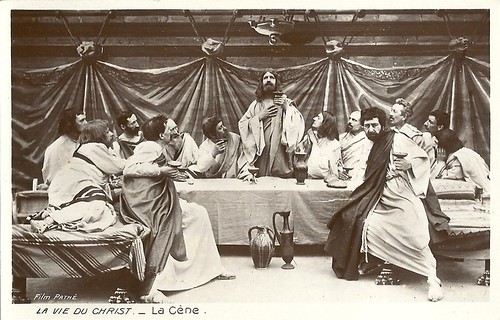
French postcard. Photo: Pathé Frères. Scene from the early Pathé film La vie du Christ aka Vie et passion de notre seigneur Jésus-Christ (Ferdinand Zecca, 1907). Caption: The Last Supper.
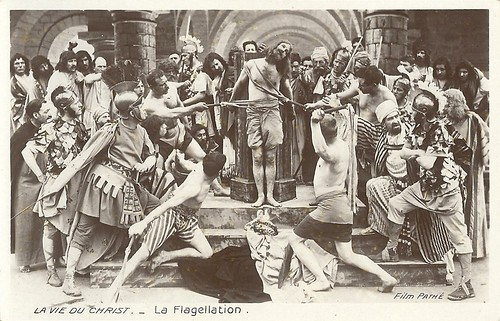
French postcard. Photo: Pathé Frères. Scene from the early Pathé film La vie du Christ aka Vie et passion de notre seigneur Jésus-Christ (Ferdinand Zecca, 1907). Caption: The Flagellation.

French postcard. Photo: Pathé Frères. Scene from the early Pathé film La vie du Christ aka Vie et passion de notre seigneur Jésus-Christ (Ferdinand Zecca, 1907). Caption: St. Veronica - The Holy Face.

French postcard. Photo: Pathé Frères. Scene from the early Pathé film La vie du Christ aka Vie et Passion de Notre Seigneur Jésus-Christ (Ferdinand Zecca, 1907). Caption: The Burial. On the right is the actress Julienne Mathieu as Virgin Mary.
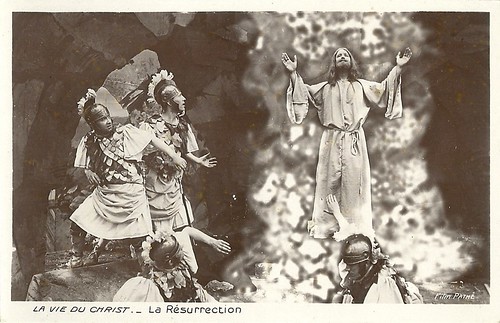
French postcard. Photo: Pathé Frères. Scene from the early Pathé film La vie du Christ aka Vie et Passion de Notre Seigneur Jésus-Christ (Ferdinand Zecca, 1907). Caption: The Resurrection.
Sources: Roberta Pearson (The Encyclopedia of Early Cinema), Richard Abel (The Ciné Goes to Town: French Cinema, 1896-1914), Ivo Blom (Jean Desmet and the Early Dutch Film Trade), and IMDb.
No comments:
Post a Comment